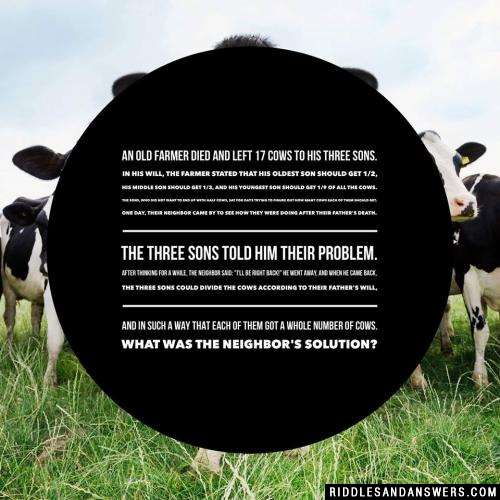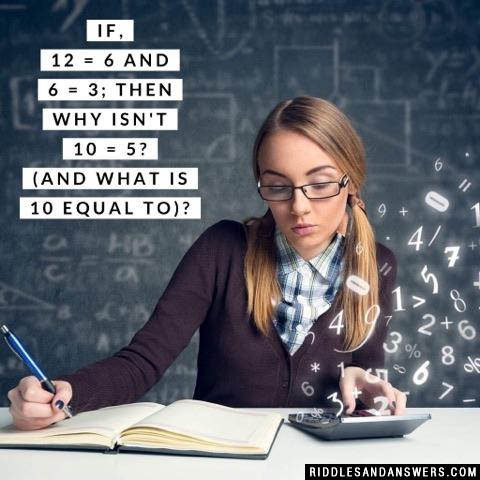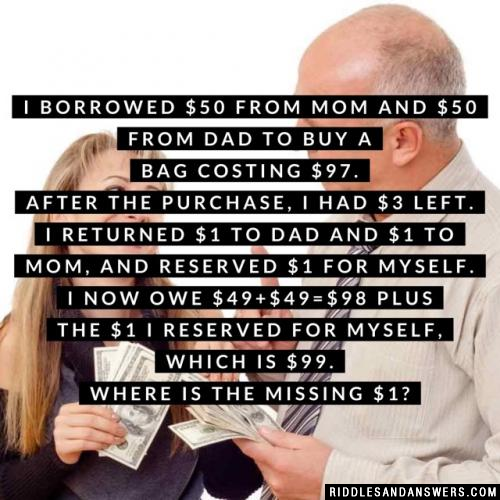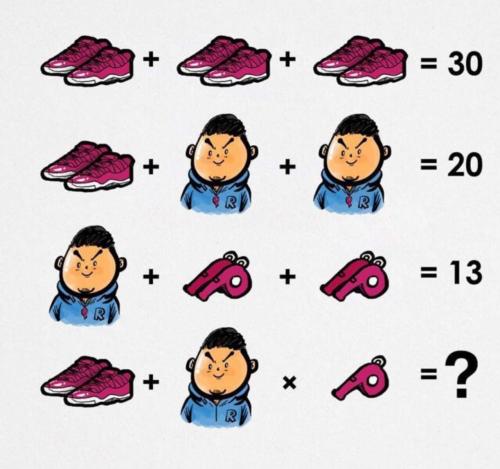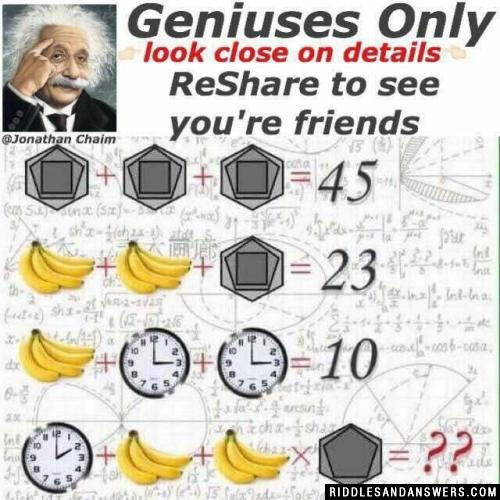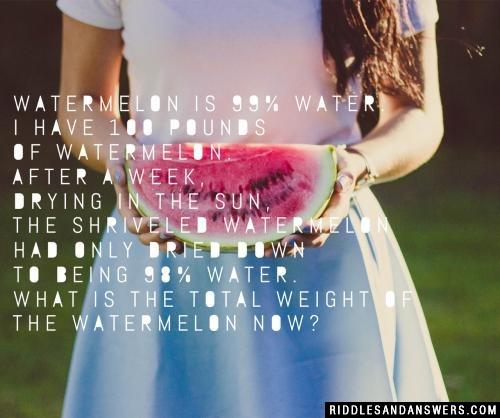Fun Facts (Hints)
Mathematics has an extensive history in just about every culture or civilized society known to man. Listed below are some cool facts to get those math juices flowing:
In 1852 mathematician JJ Sylvester established the "theory of algebraic invariants."
In 1995 math great Andrew Wiles, proved "Fermat's Last Theorem."
The first decimal number system is said to have been invented in Ancient Egypt around 5000BC.
The Ancient Mayan civilization located in Central America is one of the only cultures in the recorded history of the world to use a place-value number system.
The American Mathematical Society was formed in the late months of 1888 in New York.
Trending Tags
Feel free to use content on this page for your website or blog, we only ask that you reference content back to us. Use the following code to link this page:
Terms · Privacy · Contact
Riddles and Answers © 2021
17 Cows Riddle
An old farmer died and left 17 cows to his three sons. In his will, the farmer stated that his oldest son should get 1/2, his middle son should get 1/3, and his youngest son should get 1/9 of all the cows. The sons, who did not want to end up with half cows, sat for days trying to figure out how many cows each of them should get.
One day, their neighbor came by to see how they were doing after their father's death. The three sons told him their problem. After thinking for a while, the neighbor said: "I'll be right back!" He went away, and when he came back, the three sons could divide the cows according to their father's will, and in such a way that each of them got a whole number of cows.
What was the neighbor's solution?
One day, their neighbor came by to see how they were doing after their father's death. The three sons told him their problem. After thinking for a while, the neighbor said: "I'll be right back!" He went away, and when he came back, the three sons could divide the cows according to their father's will, and in such a way that each of them got a whole number of cows.
What was the neighbor's solution?
Hint:
The neighbour borrowed an extra cow, to make the total number of cows 18. Then the oldest son got 1/2 of 18 is 9 cows, the middle son got 1/3 of 18 is 6 cows, and the youngest son got 1/9 of 18 is 2 cows. Since 9+6+2 = 17, the cows could be divided among the three brothers in such a way that the borrowed cow was left over, and could be returned to its owner. Did you answer this riddle correctly?
YES NO
YES NO
12 = 6 And 6 = 3 Riddle
Hint:
12 (Twelve) has 6 letters,
6 (Six) has 3
Therefore,
10 (Ten) will be equal to 3 Did you answer this riddle correctly?
YES NO
6 (Six) has 3
Therefore,
10 (Ten) will be equal to 3 Did you answer this riddle correctly?
YES NO
Borrow $50 From Mom And $50 From Dad Riddle
I borrowed $50 from mom and $50 from dad to buy a bag costing $97. After the purchase, I had $3 left. I returned $1 to dad and $1 to mom, and reserved $1 for myself. I now owe $49+$49=$98 plus the $1 I reserved for myself, which is $99. Where is the missing $1?
Hint:
Total Money taken = $100($50+$50)
Now,
Bag's Price = $ 97
Remaining Amount = $100 - $97
= $ 3
Returned = $ 1 + $ 1
=$2
In pocket = $1
Total money owed = $100- ( Returned amount)
= $98( Bag's amount and reserved amount)
So, it was a calculation mistake. Did you answer this riddle correctly?
YES NO
Now,
Bag's Price = $ 97
Remaining Amount = $100 - $97
= $ 3
Returned = $ 1 + $ 1
=$2
In pocket = $1
Total money owed = $100- ( Returned amount)
= $98( Bag's amount and reserved amount)
So, it was a calculation mistake. Did you answer this riddle correctly?
YES NO
The Correct Number Riddle
Hint:
121
Explanation
Tables consist of squares of the number from 4 to 12.
11^2 = 121. Did you answer this riddle correctly?
YES NO
Explanation
Tables consist of squares of the number from 4 to 12.
11^2 = 121. Did you answer this riddle correctly?
YES NO
Steals $100 Riddle
Hint:
Shoe Man Whistle
Hint:
The third equation has a term with a pair of whistles. The last line involves a single whistle.
Furthermore, the man in the second and third lines are wearing a whistle, but the man in the last line is not wearing a whistle. Presumably the value of the whistle should be accounted for to get the correct answer.
The pictures can be translated into the following equations:
shoes + shoes + shoes = 30
shoes + (man + whistle) + (man + whistle) = 20
(man + whistle) + 2(whistles) + 2(whistles) = 13
shoes + (man) x (whistle) = ?
From the first equation we can solve for the shoes value:
shoes + shoes + shoes = 30
3(shoes) = 30
shoes = 10
We can then solve the second equation for the (man + whistle) value:
shoes + (man + whistle) + (man + whistle) = 20
10 + 2(man + whistle) = 20
2(man + whistle) = 10
man + whistle = 5
Then we solve the third equation for the whistle:
(man + whistle) + 2(whistles) + 2(whistles) = 13
5 + 4(whistles) = 13
4(whistles) = 8
whistle = 2
We also need to solve for the value of the man:
man + whistle = 5
man + 2 = 5
man = 3
Now we can evaluate the final expression, remembering the order of operations that multiplication should be evaluated before addition:
shoes + (man) x (whistle) = ?
10 + 3 x 2
= 10 + 3 x 2
= 10 + 6
= 16 Did you answer this riddle correctly?
YES NO
Furthermore, the man in the second and third lines are wearing a whistle, but the man in the last line is not wearing a whistle. Presumably the value of the whistle should be accounted for to get the correct answer.
The pictures can be translated into the following equations:
shoes + shoes + shoes = 30
shoes + (man + whistle) + (man + whistle) = 20
(man + whistle) + 2(whistles) + 2(whistles) = 13
shoes + (man) x (whistle) = ?
From the first equation we can solve for the shoes value:
shoes + shoes + shoes = 30
3(shoes) = 30
shoes = 10
We can then solve the second equation for the (man + whistle) value:
shoes + (man + whistle) + (man + whistle) = 20
10 + 2(man + whistle) = 20
2(man + whistle) = 10
man + whistle = 5
Then we solve the third equation for the whistle:
(man + whistle) + 2(whistles) + 2(whistles) = 13
5 + 4(whistles) = 13
4(whistles) = 8
whistle = 2
We also need to solve for the value of the man:
man + whistle = 5
man + 2 = 5
man = 3
Now we can evaluate the final expression, remembering the order of operations that multiplication should be evaluated before addition:
shoes + (man) x (whistle) = ?
10 + 3 x 2
= 10 + 3 x 2
= 10 + 6
= 16 Did you answer this riddle correctly?
YES NO
$100 Bill Grocery Store Thief
A guy walks into a store and steals a $100 bill from the register without the owners knowledge.
He then buys $70 worth of goods using the $100 bill and the owner gives $30 in change.
How much money did the owner lose?
$30, $70, $100, $130, $170, or $200?
He then buys $70 worth of goods using the $100 bill and the owner gives $30 in change.
How much money did the owner lose?
$30, $70, $100, $130, $170, or $200?
Hint:
The best answer from the choices is the owner lost $100. The $100 bill that was stolen was then given back to the owner. What the owner loses is the $70 worth of goods and the $30 in change, which makes for a total of $70 + $30 = $100. The owner has lost $100.
Technically, the owner lost $30 plus the value, V, of the $70 of goods. Since stores typically sell goods at a markup, the value may be less than $70. But in the case of a loss leader, the owner may have lost more than $70. Did you answer this riddle correctly?
YES NO
Technically, the owner lost $30 plus the value, V, of the $70 of goods. Since stores typically sell goods at a markup, the value may be less than $70. But in the case of a loss leader, the owner may have lost more than $70. Did you answer this riddle correctly?
YES NO
Banana Clock Riddle
Hint: 1. Look closely at the clock.
2. Number of Bananas.
3. Some thing regarding the sides of the Shapes figure.
38
Logic :
From 1st the hexagon shape has value 15.
The shape has 15 edges(6 of hexagon,5 of Pentagon and 4 of Square)
From 2nd we get value of one bunch of bananas is 4.
So each banana has value of 1.
From 3rd we get that each clock has value of 3.
Which resembles the time on the clock which is 3.
Hence by using these insights, we get the last required values as
Clock = 2 (2 in the clock)
Bananas = 3 (3 bananas in the bunch)
Hexagon = 11 (Hexagon[6 sides] and pentagon[5 sides], so 6+5=11)
So required value is
2+3+3x11=?
2+3+33=? (Multiply first - Bodmas rule)
5+33=38 and hence the answer is 38. Did you answer this riddle correctly?
YES NO
Logic :
From 1st the hexagon shape has value 15.
The shape has 15 edges(6 of hexagon,5 of Pentagon and 4 of Square)
From 2nd we get value of one bunch of bananas is 4.
So each banana has value of 1.
From 3rd we get that each clock has value of 3.
Which resembles the time on the clock which is 3.
Hence by using these insights, we get the last required values as
Clock = 2 (2 in the clock)
Bananas = 3 (3 bananas in the bunch)
Hexagon = 11 (Hexagon[6 sides] and pentagon[5 sides], so 6+5=11)
So required value is
2+3+3x11=?
2+3+33=? (Multiply first - Bodmas rule)
5+33=38 and hence the answer is 38. Did you answer this riddle correctly?
YES NO
Age Of Three Daughters Riddles
I was visiting a friend one evening and remembered that he had three daughters. I asked him how old they were. The product of their ages is 72, he answered. Quizzically, I asked, Is there anything else you can tell me? Yes, he replied, the sum of their ages is equal to the number of my house. I stepped outside to see what the house number was. Upon returning inside, I said to my host, Im sorry, but I still cant figure out their ages. He responded apologetically, Im sorry, I forgot to mention that my oldest daughter likes strawberry shortcake. With this information, I was able to determine all three of their ages. How old is each daughter?
Hint:
3, 3, and 8. The only groups of 3 factors of 72 to have non-unique sums are 2 6 6 and 3 3 8 (with a sum of 14). The rest have unique sums:
2 + 2 + 18 = 22
2 + 3 + 12 = 18
2 + 4 + 9 = 15
3 + 4 + 6 = 13
The house number alone would have identified any of these groups. Since more information was required, we know the sum left the answer unknown. The presence of a single oldest child eliminates 2 6 6, leaving 3 3 8 as the only possible answer. Did you answer this riddle correctly?
YES NO
2 + 2 + 18 = 22
2 + 3 + 12 = 18
2 + 4 + 9 = 15
3 + 4 + 6 = 13
The house number alone would have identified any of these groups. Since more information was required, we know the sum left the answer unknown. The presence of a single oldest child eliminates 2 6 6, leaving 3 3 8 as the only possible answer. Did you answer this riddle correctly?
YES NO
The Number Four Be Half Of Five Riddle
Hint:
IV, the Roman numeral for four, which is “half” (two letters) of the word five. Did you answer this riddle correctly?
YES NO
YES NO
Bus Driver Riddle
Ok, you're the bus driver, there were 20 kids on the bus. At the first stop, 2 kids get on but 5 kids get off. The second stop, 3 kids get off but 1 gets on. The third stop, 8 kids get off but only 3 kids get off. Who's the bus driver?
Hint:
Pearl Problems Riddle
"I'm a very rich man, so I've decided to give you some of my fortune. Do you see this bag? I have 5001 pearls inside it. 2501 of them are white, and 2500 of them are black. No, I am not racist. I'll let you take out any number of pearls from the bag without looking. If you take out the same number of black and white pearls, I will reward you with a number of gold bars equivalent to the number of pearls you took."
How many pearls should you take out to give yourself a good number of gold bars while still retaining a good chance of actually getting them?
How many pearls should you take out to give yourself a good number of gold bars while still retaining a good chance of actually getting them?
Hint: If you took out 2 pearls, you would have about a 50% chance of getting 2 gold bars. However, you can take even more pearls and still retain the 50% chance.
Take out 5000 pearls. If the remaining pearl is white, then you've won 5000 gold bars! Did you answer this riddle correctly?
YES NO
YES NO
Coconut Toll Booth Riddle
There is a beautiful garden surrounded with water on three sides and only one road leading to it. This garden has thousands of coconut trees. Anyone can visit to pick coconuts.
The coconuts can be taken in boxes only. Each box can carry 20 coconuts.You can take as many boxes as you like for free but there are ten toll barriers on the road. Each toll booth collects tax in the form of you guessed it: coconuts. The number of coconuts taken is equal to the number of boxes. For example if you are carrying 50 boxes of coconut you have to pay 50 coconuts at each barrier.
If you took 10 boxes filled with coconuts from garden, tell me how many coconuts would you have remaining after crossing all ten toll booths?
The coconuts can be taken in boxes only. Each box can carry 20 coconuts.You can take as many boxes as you like for free but there are ten toll barriers on the road. Each toll booth collects tax in the form of you guessed it: coconuts. The number of coconuts taken is equal to the number of boxes. For example if you are carrying 50 boxes of coconut you have to pay 50 coconuts at each barrier.
If you took 10 boxes filled with coconuts from garden, tell me how many coconuts would you have remaining after crossing all ten toll booths?
Hint:
Going To The Picnic
Mr and Mrs Smith went for a picnic. Mrs. Smith has 5 sons and each son has a sister who has 5 daughters each of whom have 1 brother each. How many of them went for the picnic?
Hint:
2 people.
It is stated clearly that Mr. and Mrs. Smith went for a picnic. It does not say that the others accompanied them. Did you answer this riddle correctly?
YES NO
It is stated clearly that Mr. and Mrs. Smith went for a picnic. It does not say that the others accompanied them. Did you answer this riddle correctly?
YES NO
The Weight Of A Melon Riddle
Watermelon is 99% water. I have 100 pounds of watermelon. After a week, drying in the sun, the shriveled watermelon had only dried down to being 98% water. What is the total weight of the watermelon now?
Hint: We are to determine X the total mass of melon after the drying.
The Dry weight, DW is 1lb both before and after the drying.
The New Water weight, WNW is clearly X - DW or X - 1
Post Your Math Brain Teasers Below
Can you come up with a cool, funny or clever Math Brain Teasers of your own? Post it below (without the answer) to see if you can stump our users.
